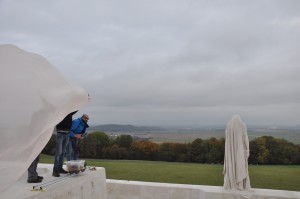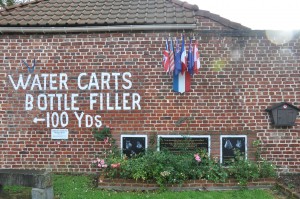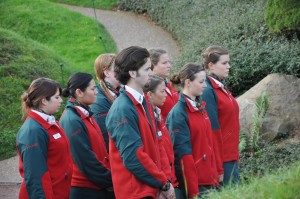In 1917, Canadian troops, with extraordinary valor and grotesque losses, took ground held by Germans since 1914. Vimy is now an enormous park; the terrain, grassy and green, retains the topography created by shellfire and the craters left my mines exploded in tunnels under German trenches. Visitors are kept to walkways by electric fences and scarlet signs that warn of the presence of unexploded ordnance. Expanses of lawn, in fields and pine groves, are kept shorn by herds of sheep. The weight and action of machinery might set something off. In fact as recently as 1998, Lt. Col. Mike Watkins, an expert in bomb disposal, found and defused a mine at Vimy. He died tragically a month or so later there in a tunnel collapse. These dangers are present at every battle site—and many less significant locales—along the Western Front.
The memorial sculpture, designed by Canadian sculptor and architect Walter Seymour Allward (1875-1955), was dedicated in the 1930s; restoration was completed in 2007. It is a soaring and potent image but I concede to a certain ambivalence about it aesthetically and emotionally.
We discovered at at the monument a film crew involved with a length of filmy pink fabric. They laid it down the steps and recorded its shape and movement as it floated one way and another. I was curious and as the crew were conversing in English—albeit each with a unique accent—I moved closer. I watched a shot that must have been beautiful and smiled at the lone female in the group. They were working on a song video she said, for her sister Lizzy Hoyt. Hoyt is a Canadian singer-songwriter-fiddler and had written a song about the battle. Sarah—Hoyt’s sister and a classical pianist—said the fabric was cut from the same bolt as Lizzy’s performance dress and that struck me as both poetic and apt, the ashes-of-roses tint of the chiffon like the light of dawn.
The song, Sarah explained, was like a traditional Celtic ballad. A lament, I thought, and indeed that was what it is. There is a refrain: Oh, my love can’t touch you now / or calm the fear that’s building deep within. / Oh, the terror you must have felt / waiting below the hill at Vimy Ridge. We found a recording on YouTube and the melody, at times a keening wail, embodied that terrible story.
On route to Thiepval and the Lutyens monument to the Dead of the Somme, we stopped at Beaumont-Hamel. I remembered this place from the book, The Danger Tree, a combination of memoir and historical narrative of a family of Newfoundlanders.
There is a special poignancy about this memorial. At the time Newfoundland was not Canadian but rather a British dependency. Its total population was something like 240,000, more like a large family than a small nation. The tragedy of lives lost and bodies broken had gripped so very many outside the circle of parents, siblings and children.
The young women who welcomed us were the same ones we had met at Vimy. Karine, a native of Ottawa, was our guide to the battleground. She is a student of health sciences at university but I hope she continues with her passion for history and her gift for speaking history’s meanings. She is an utterly remarkable nineteen-year-old.
Remembrance Day will be celebrated this Sunday, November 6, at Vimy and on November 5 at Beaumont-Hamel. We encountered a couple at Beaumont-Hamel we had seen at Vimy and shared our conversations with Sarah Hoyt. Turns out that Lizzy Hoyt will perform at both locations as part of the observances. My Dear One and I hope that we will be there too.
Postscript:
We stopped at the memorial to the animals of World War I on our way to the Remembrance observances at Beaumont-Hamel. Beasts, too, made extraordinary sacrifices to the cause. The story of a German Shepherd puppy adopted by a doughboy only to become a movie star under the name Rin-Tin-Tin is perhaps the best known. There was also the carrier pigeon, Cher Ami, who despite wounds inflicted by German shooters, was able to bring a message about the location and circumstances of the American “Lost Battalion” pinned down in the Argonne by both enemy and friendly fire. In recent months, the play War Horse, adapted from the novel by English writer Michael Morpurgo has filled the theater at New York City’s Lincoln Center. Joey—like his ancestor Black Beauty—tells a story about the human heart, its courage and its failures to which he is witness as an English officer’s mount, then a cart horse for the Germans. The war fought on all Fronts depended on the contribution of countless animals: horses, burros and mules, dogs and carrier pigeons. They provided a sense of the ordinary and good in a soldier’s world of desperation and futility; so many made a soldier’s sacrifice.
Dignitaries and guests had already assembled as we made our way to the Newfoundlander’s monument. Representatives from Canada’s armed forces were there as well as members of veteran’s groups. Visitors like ourselves stood on high ground, a little apart. The service was formal, brief and deeply moving. Representatives of the Canadian and French governments read their remarks in French and English; a minister offered prayers, also in both languages. The young guides brought out floral tributes that honored guests then placed at the memorial as Lizzy and Sarah Hoyt offered music: Ashokan Farewell, Amazing Grace, Danny Boy, soft, sad, serene. The last wreath was a gift of the Youth of Canada / Jeunes du Canada and I was happy to see that Karine was half of the pair chosen to place it in the center of all the others.
After the Remembrance we spoke with the Hoyts and chatted with a young Canadian named Jordan who is working in Paris as an English teacher (back in Canada he is pursuing a degree in math with a minor in French). He had made the trek by train and taxi, drawn by opportunity and a sense of belonging. We returned to the Visitor Center together and found Karine there. After a quick reunion and hug we were on our way to Crécy-la-Chapelle where we would spend the last week of this voyage. The young folk headed off to the reception.










